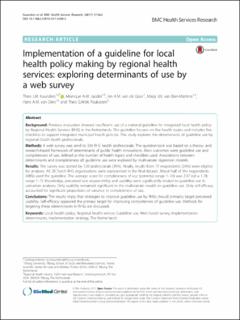Implementation of a guideline for local health policy making by regional health services: exploring determinants of use by a web survey
Kuunders, T. J.; Jacobs, M. A.; van de Goor, I. A.; van Bon-Martens, M. J.; van Oers, H. A.; Paulussen, T. G.
Journal article

Åpne
Permanent lenke
https://hdl.handle.net/11250/3040614Utgivelsesdato
2017Metadata
Vis full innførselSamlinger
Originalversjon
Kuunders, T. J., Jacobs, M. A., van de Goor, I. A., van Bon-Martens, M. J., van Oers, H. A. & Paulussen, T. G. (2017). Implementation of a guideline for local health policy making by regional health services: exploring determinants of use by a web survey. BMC health services research, 17(1), 1–10. https://doi.org/10.1186/s12913-017-2499-2Sammendrag
Background
Previous evaluation showed insufficient use of a national guideline for integrated local health policy by Regional Health Services (RHS) in the Netherlands. The guideline focuses on five health topics and includes five checklists to support integrated municipal health policies. This study explores the determinants of guideline use by regional Dutch health professionals.
Methods
A web survey was send to 304 RHS health professionals. The questionnaire was based on a theory- and research-based framework of determinants of public health innovations. Main outcomes were guideline use and completeness of use, defined as the number of health topics and checklists used. Associations between determinants and (completeness of) guideline use were explored by multivariate regression models.
Results
The survey was started by 120 professionals (39%). Finally, results from 73 respondents (24%) were eligible for analyses. All 28 Dutch RHS organizations were represented in the final dataset. About half of the respondents (48%) used the guideline. The average score for completeness of use (potential range 1–10) was 2.37 (sd = 1.78; range 1–7). Knowledge, perceived task responsibility and usability were significantly related to guideline use in univariate analyses. Only usability remained significant in the multivariate model on guideline use. Only self-efficacy accounted for significant proportions of variance in completeness of use.
Conclusions
The results imply that strategies to improve guideline use by RHSs should primarily target perceived usability. Self-efficacy appeared the primary target for improving completeness of guideline use. Methods for targeting these determinants in RHSs are discussed.
